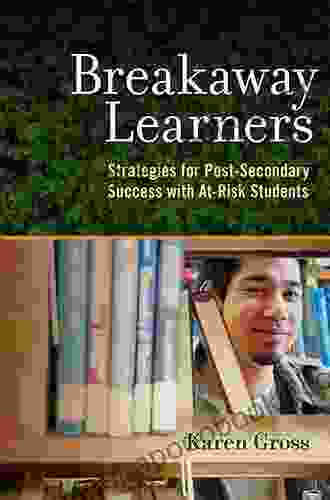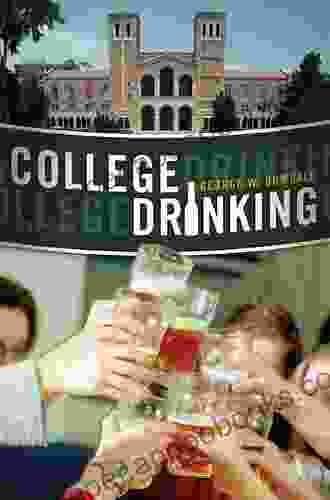Strategies For Post Secondary Success With At Risk Students: A Comprehensive Guide

Post-secondary education is increasingly becoming a necessity for success in today's competitive job market. However, for at-risk students, the transition to and through post-secondary education can be particularly challenging. These students often face a multitude of barriers, including academic, financial, and personal difficulties, that can make it difficult for them to succeed.
5 out of 5
| Language | : | Spanish |
| File size | : | 3294 KB |
| Text-to-Speech | : | Enabled |
| Screen Reader | : | Supported |
| Enhanced typesetting | : | Enabled |
| Print length | : | 163 pages |
| Lending | : | Enabled |
This comprehensive guide provides strategies and best practices for educators, administrators, and parents to support and empower at-risk students in post-secondary education. By understanding the challenges these students face and implementing effective interventions, we can help them overcome these barriers and achieve their full potential.
Understanding the Challenges Faced by At-Risk Students
At-risk students come from a variety of backgrounds and experiences, but they all share some common challenges that can make it difficult for them to succeed in post-secondary education. These challenges include:
- Academic challenges: At-risk students may have difficulty with reading, writing, and math skills. They may also have difficulty understanding and applying abstract concepts.
- Financial challenges: At-risk students often come from low-income families and may not be able to afford the cost of tuition, fees, and other expenses associated with post-secondary education.
- Personal challenges: At-risk students may have experienced trauma, abuse, or neglect. They may also have mental health issues or other personal challenges that can make it difficult for them to focus on their studies.
These challenges can create a significant barrier to success for at-risk students. However, by understanding these challenges and implementing effective interventions, we can help them overcome these obstacles and achieve their goals.
Strategies for Supporting At-Risk Students
There are a number of strategies that can be used to support at-risk students in post-secondary education. These strategies include:
- Academic support: At-risk students may need additional academic support, such as tutoring, mentoring, and supplemental instruction, to help them succeed in their coursework.
- Financial support: At-risk students may need financial assistance, such as scholarships, grants, and loans, to help them pay for the cost of tuition, fees, and other expenses associated with post-secondary education.
- Personal support: At-risk students may need personal support, such as counseling, mentoring, and support groups, to help them overcome personal challenges and focus on their studies.
By providing at-risk students with the support they need, we can help them overcome the challenges they face and achieve their full potential.
Best Practices for Educators
Educators play a critical role in supporting at-risk students in post-secondary education. The following are some best practices for educators:
- Create a welcoming and supportive classroom environment. At-risk students need to feel safe and supported in Free Download to learn. Educators can create this environment by being respectful, understanding, and responsive to the needs of their students.
- Use differentiated instruction. At-risk students learn in different ways. Educators can use differentiated instruction to meet the individual needs of their students by providing them with different learning materials, activities, and assessments.
- Provide extra support. At-risk students may need extra support, such as tutoring, mentoring, and supplemental instruction, to succeed in their coursework. Educators can provide this support by working with their students outside of class, connecting them with resources, and advocating for their needs.
- Build relationships with students. At-risk students need to feel connected to their educators. Educators can build relationships with their students by getting to know them outside of class, attending their events, and being supportive of their goals.
By following these best practices, educators can create a positive and supportive learning environment for at-risk students and help them succeed in their post-secondary education.
At-risk students face a number of challenges in post-secondary education. However, by understanding these challenges and implementing effective strategies, we can help them overcome these barriers and achieve their full potential. By providing at-risk students with the support they need, we can help them succeed in post-secondary education and go on to lead successful and fulfilling lives.
5 out of 5
| Language | : | Spanish |
| File size | : | 3294 KB |
| Text-to-Speech | : | Enabled |
| Screen Reader | : | Supported |
| Enhanced typesetting | : | Enabled |
| Print length | : | 163 pages |
| Lending | : | Enabled |
Do you want to contribute by writing guest posts on this blog?
Please contact us and send us a resume of previous articles that you have written.
 Book
Book Novel
Novel Page
Page Chapter
Chapter Text
Text Story
Story Genre
Genre Reader
Reader Library
Library Paperback
Paperback E-book
E-book Magazine
Magazine Newspaper
Newspaper Paragraph
Paragraph Sentence
Sentence Bookmark
Bookmark Shelf
Shelf Glossary
Glossary Bibliography
Bibliography Foreword
Foreword Preface
Preface Synopsis
Synopsis Annotation
Annotation Footnote
Footnote Manuscript
Manuscript Scroll
Scroll Codex
Codex Tome
Tome Bestseller
Bestseller Classics
Classics Library card
Library card Narrative
Narrative Biography
Biography Autobiography
Autobiography Memoir
Memoir Reference
Reference Encyclopedia
Encyclopedia Jamie Brown Hantman
Jamie Brown Hantman Sierra Hill
Sierra Hill Joan Lipinsky Cochran
Joan Lipinsky Cochran Rich Bard
Rich Bard Scott Joplin
Scott Joplin Gerald Graff
Gerald Graff Julia B Kingsley
Julia B Kingsley Megan Nicolay
Megan Nicolay Glenn Boozan
Glenn Boozan Greg Keyes
Greg Keyes Grantlee Kieza
Grantlee Kieza Patrick Collier
Patrick Collier George Yool
George Yool Joel S Schuman Md
Joel S Schuman Md Jules Gilleland
Jules Gilleland Viola Davis
Viola Davis Rupert Colley
Rupert Colley Gary Giddins
Gary Giddins Gerard Kilroy
Gerard Kilroy Grace Meyers
Grace Meyers
Light bulbAdvertise smarter! Our strategic ad space ensures maximum exposure. Reserve your spot today!

 William FaulknerThree Conspiracies: Field Marshal Rundstedt, Admiral Canaris, and the Jewish
William FaulknerThree Conspiracies: Field Marshal Rundstedt, Admiral Canaris, and the Jewish
 Isaiah PowellUnveiling the Exquisite Beauty of Artemorbida Textile Arts Magazine, Issue 02...
Isaiah PowellUnveiling the Exquisite Beauty of Artemorbida Textile Arts Magazine, Issue 02...
 Douglas AdamsDiscover the Fabric of American Conservatism: Unveil the Intricate Tapestry...
Douglas AdamsDiscover the Fabric of American Conservatism: Unveil the Intricate Tapestry...
 Geoffrey BlairJourney to the Enchanting Isle of Destiny: Discover the Captivating Spear...
Geoffrey BlairJourney to the Enchanting Isle of Destiny: Discover the Captivating Spear... Greg CoxFollow ·7.8k
Greg CoxFollow ·7.8k Raymond ParkerFollow ·13.5k
Raymond ParkerFollow ·13.5k Andres CarterFollow ·18k
Andres CarterFollow ·18k Dominic SimmonsFollow ·2.8k
Dominic SimmonsFollow ·2.8k Clarence MitchellFollow ·9.1k
Clarence MitchellFollow ·9.1k John UpdikeFollow ·13.7k
John UpdikeFollow ·13.7k Jonathan FranzenFollow ·10.1k
Jonathan FranzenFollow ·10.1k Larry ReedFollow ·10k
Larry ReedFollow ·10k

 Ken Follett
Ken FollettDiscover the Enchanting World of Classical Piano with "10...
A Symphony of Timeless...

 Cody Russell
Cody RussellTheo On The Ice Boston Bay Vikings: A Hockey Adventure...
Theo On The Ice...

 Nathaniel Hawthorne
Nathaniel HawthorneBach for Easy Guitar: Unleash the Genius of the Baroque...
Johann Sebastian Bach, the undisputed...

 Brenton Cox
Brenton CoxAfrican Recipes For Every Concern: Delicious,...
Embark on a Culinary Journey to the Heart of...

 Lawrence Bell
Lawrence BellEasy Guitar With Notes Tab: Your Ultimate Guide to...
Unlock the World...

 Brenton Cox
Brenton CoxCarter On The Ice: A Thrilling Sports Novel
Synopsis ...
5 out of 5
| Language | : | Spanish |
| File size | : | 3294 KB |
| Text-to-Speech | : | Enabled |
| Screen Reader | : | Supported |
| Enhanced typesetting | : | Enabled |
| Print length | : | 163 pages |
| Lending | : | Enabled |




